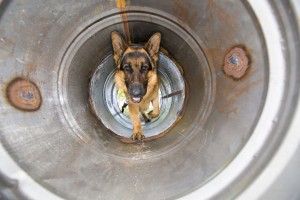 It’s back to school season…for dogs? Yes! Many canines enjoy the challenges that come with learning new tricks and being mentally and physically put to the test. Higher level training classes, as well as agility training, often appeal to breeds that need to be moving, working, and mentally engaged.
It’s back to school season…for dogs? Yes! Many canines enjoy the challenges that come with learning new tricks and being mentally and physically put to the test. Higher level training classes, as well as agility training, often appeal to breeds that need to be moving, working, and mentally engaged.
Dogs that traditionally fall into this class of high-achievers include: border collies, Jack Russell terriers, standard poodles, papillions, Pembroke Welsh corgis, Australian shepherds, and German shepherds. However, any dog can benefit from additional training classes that are fun, offer opportunities to be around other dogs, and provide plenty of praise.
If your dog has gone through the obedience and socialization classes and loved the interaction and test, you may want to consider agility training or advanced trick training.
Trick Training: Why Some Dogs Go Wild for It
Teaching your dog tricks is a wonderful way to strengthen your bond as well as provide mental stimulation.
The primary goal of trick training is having fun. It doesn’t replace the more important foundational training in positive reinforcement based obedience and cue response. It is, however, an awesome add-on for dogs who enjoy learning and performing.
Trick training uses the same positive reinforcement or reward methods (treats, clicker, etc.) as basic cue training, with repetition and reward. Starting with simple tricks, such as “shake” and “roll over”, pet owners can gradually increase the complexity of the tricks, like jumping rope and identifying objects by name.
Some dogs just live for adoration. Trick training is a great resource for building confidence, calming overly hyper or excitable dogs, and giving you a way to effectively communicate with your best friend.
Agility Training for Your Star Pupil
When it comes to problem behaviors, boredom is often at the source. Canines are social, active animals, especially those that were bred to herd, hunt, or work in some capacity. Without the means to fulfill these instincts, many dogs will display behaviors you do not want, such as barking and chewing, or will experience malaise.
That is why agility training can be the perfect choice for high-energy, motivated breeds to work off some steam.
Agility training generally consists of an obstacle course containing a dozen or more obstacles referred to as contacts. The goal is to get your dog to move swiftly and successfully through these obstacles as you provide eye contact or whistle cues.
What is most exciting about this form of training is the subtle, yet powerful communication it builds between you and your dog.
Other benefits of agility training include:
We hope you and your best friend find ways to increase daily exercise and learning opportunities. Trick and agility training are incredible tools to use when your dog excels in physical and mental exercises. Give them a try!
And, as a reminder, your friends at Billings Animal Family Hospital offer puppy training and socialization classes, an essential component to raising a well-adjusted, happy, and healthy dog.



